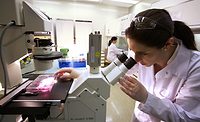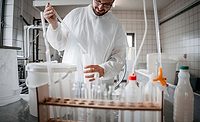Reduce Risk and Improve Efficiency with In-House Environmental Monitoring
Globalization of the food supply, changing consumer trends, new regulatory requirements, and increased media attention are changing the way we think about food safety. Consumers are more aware of where their food comes from and are demanding manufacturers produce products free from antibiotics, preservatives, and additional additives. Consumers’ eating habits are changing, and convenient ready-to-eat options are in demand. Consumers with healthy eating goals have begun actively to choose organic and gluten-free foods. In light of the increasing prevalence of food allergies, food manufacturers are under the magnifying glass to improve their allergen control and labeling programs. Highly publicized food recalls are putting more intense pressure on food manufacturers to streamline and secure their food safety procedures.
This increased scrutiny has resulted in a shift in how food manufacturers look at their food safety systems. The implementation of the U.S. Food and Drug Administration’s Food Safety Modernization Act (FSMA) is changing the mindset to a preventive approach. This act identifies three specific preventive controls, or PCs (allergen controls, supplier verification, and sanitation) that together are intended to support other prerequisite programs and Good Manufacturing Practices already in place to prevent contamination.
Pathogen Growth Niches: Seek and Destroy
Sanitation, one of the PCs required by FSMA, is critical in preventing both biological and chemical contaminants. These contaminants can vary widely from chemicals (e.g., food allergens) to biological organisms (including pathogens, viruses, and parasites). The best Sanitation Standard Operating Procedures (SSOPs) include a recommended schedule for cleaning and sanitizing based on the design of the equipment, the degree of product exposure during postlethality handling, and the history of pathogens/allergens on a particular production line. How then do processors know if their SSOPs are effective? The answer is simple: by monitoring their processing environment (also known as environmental monitoring).
The processing environment is particularly susceptible to food pathogens, making pathogen testing a crucial component of any environmental monitoring program (EMP). Gone are the days when manufacturers perform only finished product testing. EMPs allow a food manufacturer to find pathogen growth niches in the production area and take action to eliminate risk before the food becomes contaminated (i.e., “seek and destroy”). Testing for pathogens within the processing environment provides vital information on areas that need extra attention. Quick corrective actions result in a safer production environment, the ultimate goal of an effective EMP.
Effective, Efficient Listeria and Salmonella Control with Romer Labs® RapidChek®
Testing for pathogens has been streamlined from the days when only highly trained microbiologists could administer such tests. Rapid pathogen methods can now be run effectively by team members with differing functions and various levels of scientific training. There are many rapid pathogen detection methods available on the market. They vary in what they detect, time-to-results, number of steps, equipment needed to run the assay or interpret the result, and cost. Critical actions are taken in response to test results, so the method a food manufacturer chooses must be robust, reliable, and fast.
Think about your current EMP and pathogen detection method. Ask yourself: Is it efficient? How many steps are there? How long do I have to wait? What impact does my EMP have on day-to-day production efficiencies? With Romer Labs RapidChek, there is no need for any extra equipment to interpret the results and therefore no need for substantial investment. With our latest, all-in-one sampling device combined with pre-made RapidChek Listeria NextDay™ enrichment media and lateral flow device, samples taken at the processing plant require very little hands-on time in the laboratory. Samples arrive and are immediately placed into the incubator and tested after 24 hours of enrichment. The test time is only 10 minutes. This means accelerated time-to-results and reduced waiting times. With RapidChek, results can be obtained faster and corrective actions can be taken sooner to prevent pathogens from making their way into the product: This is how RapidChek can help you reach your EMP goals and improve production efficiencies.
Don’t overcomplicate this decision. Get reliable results using the most effective method on the market. Simplify environmental testing with RapidChek by Romer Labs. Our lateral flow-based methods for Listeria and Salmonella provide a rapid, reliable, and streamlined workflow to perform environmental testing without incurring a significant increase in cost. Hundreds of samples can be tested in a single day without delays due to batch requirements on equipment-based methods. A state-of-the-art EMP is attainable. Take a moment to make your life easier and contact Romer Labs.
Looking for a reprint of this article?
From high-res PDFs to custom plaques, order your copy today!









